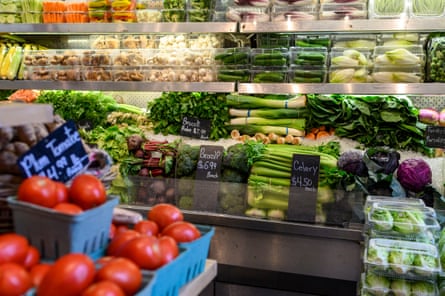The hidden cost of a shutdown: America’s battle with food insecurity | Food poverty
With 1 October 2023 looming, a US government shutdown appears imminent, and the farm bill is set to expire. Members of both the House and Senate have been drafting proposals for its renewal, which happens every five years. The bill is responsible for financing the Supplemental Nutrition Assistance Program (SNAP) that many Americans rely on to feed their families.
Though hunger prevention advocates are calling for Congress to renew the bill before its expiration, the likelihood of a freshly revised iteration being near completion by the end of the day is low. Yet, food insecurity continues to rise in America.
More than 34 million people, including nine million children, are struggling to put food on the table.
In a recent household survey conducted by the US Census Bureau, more than 26 million Americans said they did not have enough to eat during the 12-day period of the study that concluded this month. That sample represents nearly a 50 percentage increase during a similar window from 2021. This upsurge is due to a number of factors, including the end of pandemic-era aid.
Another study released this month by Feeding America reflected a similar finding, emphasizing the far-reaching consequences of hunger.
That report underscored how the pandemic reshaped the landscape of food insecurity and its lingering effects, signaling one of America’s gravest growing crises. Approximately 80% of Americans experiencing hunger believe that inflation and rising food costs have worsened the issue of hunger nationwide and 93% of those surveyed expressed concern that the situation will deteriorate even more. They highlighted factors such as rising housing costs, job loss, unemployment, the presence of chronic health conditions or disabilities, and an abundance of low-paying jobs as significant contributors and interconnected root causes of their food vulnerability.
“The pandemic not only put hunger in the spotlight, it also revealed just how many Americans were put in a situation that kept them from accessing the food they needed,” a spokesperson for Feeding America, a network of over 200 food banks nationwide, said. “And now, food prices and supply chain disruptions are affecting food banks, and households’ budgets for millions of families are tightening.”
Another element of the rise in food insecurity, which saw almost 50 million Americans turning to food pantries and soup kitchens in 2022, is cuts to social assistance and fixed-income programs like food stamps, the child tax credit and pensions.
“When someone is on a fixed income, it’s usually due to a disability, or that they are seniors,” said Marian Hutchins, executive director of the Father’s Heart Ministries. “Someone on disability is not allowed to work if they are receiving money for social security disability. So unless they can work and have it be off the books, they cannot get resources to match the rising cost of food.”

Many who work on the front lines, like Hutchins, say the pandemic exacerbated this epidemic and exposed deep-seated vulnerabilities in our food systems and economic structures.
At the non-profit Hutchins runs on the Lower East Side of New York, she said many keep returning because they tell her they simply can’t afford basic necessities, including food, on their own. And that number continues to be staggering, compounded by the end of the extra pandemic-era Snap – formerly the Food Stamp Program, which is still commonly referred to as just food stamps – benefits.
Among their other food programs and services, the Father’s Heart Ministries, founded in 1997, hands out roughly 1,100 food pantry bags in a two-and-a-half hour window on Saturdays. Pre-pandemic, they averaged 560 guests in that same window. That’s a 96% increase. They’ve also seen a rise in new guest registration. Before the pandemic, they averaged 13 per Saturday – (during the pandemic, it was 43 per Saturday) – now, it’s closer to 20. That’s a 53% increase.
Many reports and similar organizations echo this stark and steady increase, correlating it to the nearly 60% historic increase in poverty.
“The Feeding America network of food banks distributed 5.3bn meals in fiscal year 2023,” the organization’s spokesperson said. “The latest Feeding America food bank pulse survey data shows that around 70% of responding food banks report seeing demand for food assistance increase or stay the same in July 2023 compared to June.”
The CEO of City Harvest, New York City’s largest food rescue organization, Jilly Stephens, resonated those sentiments.
“Average monthly visits to New York City food pantries and soup kitchens this year are up more than 60% compared to 2019,” she said. “City Harvest programs alone are seeing nearly 1m more visits each month than in 2019. In fact, the number of visits is nearly as high as at any point over the last three years. We know from previous crises that it can take years for food security levels to recover, and we expect the need to remain high for several years.”
The pandemic has also particularly aggravated food insecurity among families with children and communities of color, who were already disproportionately affected by hunger before the outbreak. Many of these households don’t meet the eligibility criteria for federal nutrition programs, forcing them to turn to local food banks and other community food assistance programs for additional support. Research shows that there is a higher prevalence of hunger in African American, Latino and Native American communities that can be attributed to systemic racial injustices.
Hutchins said food poverty is not as recognized of an issue as it once was because the glaring exigency of the pandemic has dwindled, so many Americans assume things are back to normal. But for many families struggling to feed their families, that’s far from the reality.
“There was a lot of public awareness during the pandemic,” Hutchins said, “where media showed lines of people at soup kitchens and food pantries. People think it’s over now, but the same crazy food prices that we are all facing are being faced by those who have no alternatives but community food pantries. No one is talking about seniors or single-parent homes. Ignoring the problem could create more problems not only for our guests but for communities in general as people become desperate to survive.”
That desperation to survive fueled by rising food costs is palpable. According to the Feeding America report, nearly 70% of Americans believe that the primary causes of hunger and food insecurity are inflation and increasing food prices.
Food prices have been inflating in recent months due to factors such as supply chain disruptions and the war in Ukraine. According to the Bureau of Labor Statistics, the Consumer Price Index for food increased by 7.1% in July 2023 compared to the previous year.
According to the recent food price outlook report from the US Department of Agriculture (USDA), it is expected that food prices will see a 5.9% increase this year.
Specifically, prices for food at home – groceries from supermarkets – rose by 0.4% from June to July 2023 and were 3.6% higher compared to July 2022.

The report also highlights expectations of continued price hikes across 10 food-at-home categories: beef and veal (4.2% increase), other meats (4.8%), poultry (3%), dairy products (4.1%), fats and oils (9.6%), processed fruits and vegetables (9.2%), sugar and sweets (9.3%), cereals and bakery products (9%), nonalcoholic beverages (7.6%) and other foods (7.4%).
With no immediate end in sight, hunger prevention programs like the Father’s Heart Ministries have stepped in to fill the gap, turning to food organizations like City Harvest for ongoing support.
Stephens said City Harvest supports grants and programs that provide funding and support for food access and justice solutions “led or informed by people with lived expertise, like the people that operate or participate in pantry services”.
“Local food initiatives are critical to fighting food insecurity,” she continued, “because no one knows their neighborhood’s assets and challenges better than the people who live and work there.”
Though many on the frontlines acknowledge there is no quick fix to food insecurity, they note that awareness is essential, and concerted efforts are needed to create lasting change and ensure that no one goes hungry. To address the widening gap of food deserts and overall insecurity in America, many advocates like Stephens and Hutchins are calling for increased Snap benefits, investing in workforce development and job training programs and initiatives, tackling the root causes of poverty and inequality through policy changes, and expanded access to food banks and other community-based food assistance programs.
“One of the best ways to reduce food insecurity is a stronger farm bill,” Stephens said, “which is being reauthorized by Congress this year. The vast majority of the farm bill’s budget is devoted to the Supplemental Nutrition Assistance Program.”
While emphasizing the importance of transformative policy, Hutchins added that food insecurity is also a community-level issue.
“Contributing and volunteering at places that are already providing food is the best way to start,” Hutchins said. “We can talk about the problem, but showing up to help is what our volunteers do.”
[ad_2]
Source link


